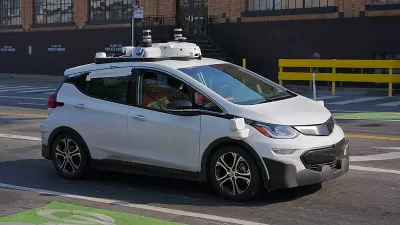On January 8, the U.S. Department of Transportation released "Ensuring American Leadership in Automated Vehicle Technologies: Automated Vehicles 4.0 (AV 4.0)." On January 11, it followed up with the Automated Vehicles Comprehensive Plan (AVCP).

The U.S. Department of Transportation on Monday released the "Automated Vehicles Comprehensive Plan" (AVCP), with stated goals to "promote collaboration and transparency, modernize the regulatory environment, and prepare the transportation system for the safe integration of Automated Driving Systems (ADS)," according to a U.S. DOT press release.
"This comprehensive plan lays out a vision for the safe integration of automated vehicles into America’s transportation system while ensuring that legitimate concerns about safety, security, and privacy are addressed," according to a statement from Secretary Elaine L. Chao, whose controversial resignation from the position became official on the day the AVCP was announced.
The AVCP builds on previous work by the U.S. Government to prepare for autonomous vehicles, outlined most recently in "Ensuring American Leadership in Automated Vehicle Technologies: Automated Vehicles 4.0" (AV 4.0), released earlier this month for attendees of the all-digital CES confab. An article by David Shepardson provides insight into the AV 4.0 document, quoting former Secretary Chao disparaging the approach of the Obama administration to autonomous vehicle regulation.
"The 51-page 4.0 policy document released [on January 8] says the U.S. government will adopt and promote 'flexible, technology-neutral policies that will allow the public, not the federal government or foreign governments, to choose the most economically efficient and effective transportation and mobility solutions,'" writes Shepardson.
FULL STORY: U.S. Department of Transportation Releases Automated Vehicles Comprehensive Plan

Planetizen Federal Action Tracker
A weekly monitor of how Trump’s orders and actions are impacting planners and planning in America.

Restaurant Patios Were a Pandemic Win — Why Were They so Hard to Keep?
Social distancing requirements and changes in travel patterns prompted cities to pilot new uses for street and sidewalk space. Then it got complicated.

Map: Where Senate Republicans Want to Sell Your Public Lands
For public land advocates, the Senate Republicans’ proposal to sell millions of acres of public land in the West is “the biggest fight of their careers.”

Maui's Vacation Rental Debate Turns Ugly
Verbal attacks, misinformation campaigns and fistfights plague a high-stakes debate to convert thousands of vacation rentals into long-term housing.

San Francisco Suspends Traffic Calming Amidst Record Deaths
Citing “a challenging fiscal landscape,” the city will cease the program on the heels of 42 traffic deaths, including 24 pedestrians.

California Homeless Arrests, Citations Spike After Ruling
An investigation reveals that anti-homeless actions increased up to 500% after Grants Pass v. Johnson — even in cities claiming no policy change.
Urban Design for Planners 1: Software Tools
This six-course series explores essential urban design concepts using open source software and equips planners with the tools they need to participate fully in the urban design process.
Planning for Universal Design
Learn the tools for implementing Universal Design in planning regulations.
Heyer Gruel & Associates PA
JM Goldson LLC
Custer County Colorado
City of Camden Redevelopment Agency
City of Astoria
Transportation Research & Education Center (TREC) at Portland State University
Camden Redevelopment Agency
City of Claremont
Municipality of Princeton (NJ)





























